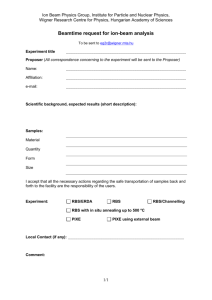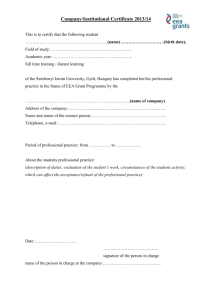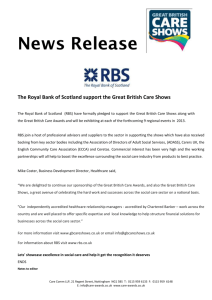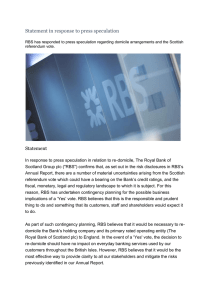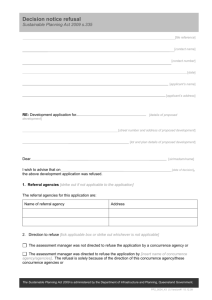Results of a Randomized Trial of Web-based Responsible
advertisement
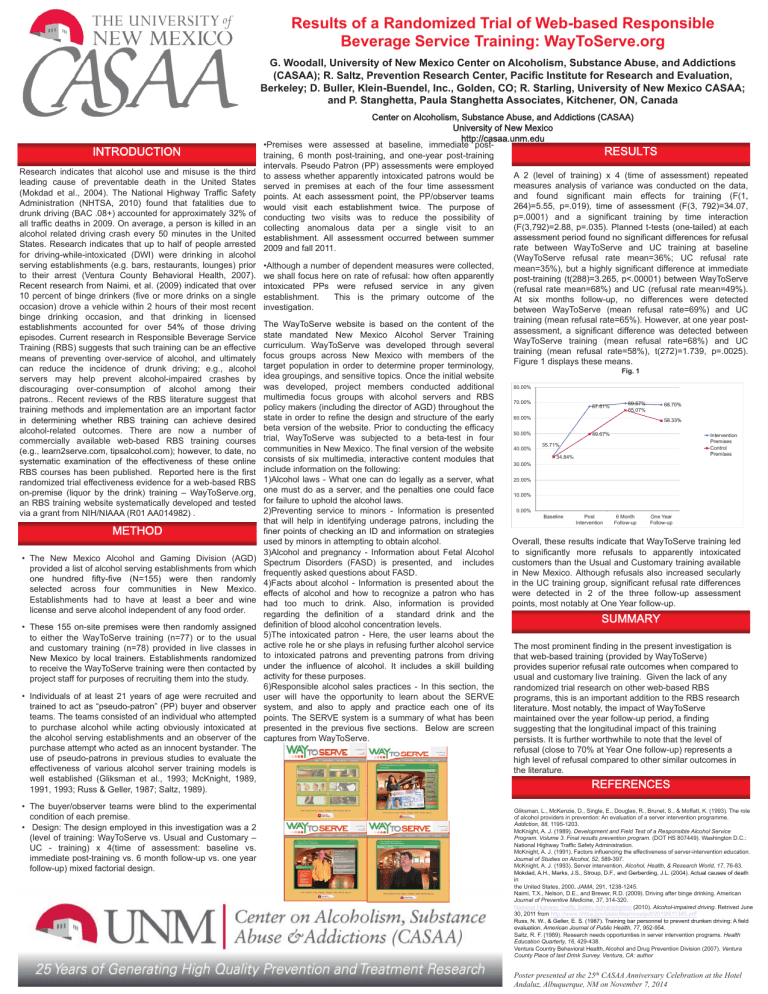
Results of a Randomized Trial of Web-based Responsible Beverage g Service Training: g WayToServe WayToServe.org y org g G. Woodall G Woodall, University of New Mexico Center on Alcoholism, Alcoholism Substance Abuse, Abuse and Addictions ((CASAA); ); R. Saltz,, Prevention Research Center,, Pacific Institute for Research and Evaluation,, Berkeley; D. D Buller, Buller Klein-Buendel, Klein Buendel Inc., Inc Golden, Golden CO; R. R Starling, Starling University of New Mexico CASAA; and P. Stanghetta, Paula Stanghetta Associates, Kitchener, ON, Canada ,1752'8&7,21 Research indicates that alcohol use and misuse is the third leading cause of preventable death in the United States (M kd d ett al., (Mokdad l 2004). 2004) The Th National N ti l Highway Hi h T ffi Safety Traffic S f t Administration ((NHTSA,, 2010)) found that fatalities due to drunk driving (BAC .08+) 08+) accounted for approximately 32% of all traffic deaths in 2009. 2009 On average, average a person is killed in an alcohol related driving g crash everyy 50 minutes in the United States Research indicates that up to half of people arrested States. for driving-while-intoxicated driving while intoxicated (DWI) were drinking in alcohol serving i establishments bli h ( (e.g. b bars, restaurants, lounges) l ) prior i to their arrest (Ventura County Behavioral Health, 2007). Recent research from Naimi, Naimi et al. al (2009) indicated that over 10 percentt off binge bi di k drinkers (fi or more drinks (five d i k on a single i l occasion)) drove a vehicle within 2 hours of their most recent binge drinking occasion, occasion and that drinking in licensed establishments t bli h t accounted t d for f over 54% off those th di i driving episodes. p Current research in Responsible p Beverage g Service Training (RBS) suggests that such training can be an effective means of preventing over-service over service of alcohol, alcohol and ultimately can reduce the incidence of drunk driving; g e.g., g alcohol servers may help prevent alcohol alcohol-impaired impaired crashes by discouraging over-consumption over consumption of alcohol among their patrons.. t R Recent t reviews i off the th RBS literature lit t suggestt that th t training methods and implementation are an important factor in determining whether RBS training can achieve desired alcohol-related l h l l t d outcomes. t Th There are now a number b off commerciallyy available web-based RBS training g courses (e g learn2serve.com, (e.g., learn2serve com tipsalcohol.com); tipsalcohol com); however, however to date, date no systematic examination of the effectiveness of these online RBS courses has been p published. Reported p here is the first randomized trial effectiveness evidence for a web web-based based RBS on premise (liquor by the drink) training – WayToServe.org, on-premise WayToServe org an RBS training t i i website b it systematically t ti ll developed d l d and d tested t t d via a grant from NIH/NIAAA (R01 AA014982) . 0(7+2' • Th The New N M i Mexico Al h l and Alcohol d Gaming G i Di i i Division (AGD) provided p o ded a list st o of a alcohol co o se serving g estab establishments s e ts from o which c one hundred fifty-five (N=155) were then randomly selected l t d across four f communities iti i in N New M i Mexico. Establishments had to have at least a beer and wine license and serve alcohol independent of any food order. order • These 155 on-site on site premises were then randomly assigned t either to ith the th WayToServe W T S t i i training ( 77) or to (n=77) t the th usuall and a d cus customary o a y training a g ((n=78) 8) p provided o ded in live e c classes asses in New Mexico by local trainers. trainers Establishments randomized t receive to i the th WayToServe W T S t i i were then training th contacted t t d by b project p j staff for p purposes p of recruiting g them into the study. y • Individuals of at least 21 years of age were recruited and trained to act as “pseudo pseudo-patron patron” (PP) buyer and observer t teams. Th teams The t consisted i t d off an individual i di id l who h attempted tt t d to p purchase alcohol while acting g obviouslyy intoxicated at the alcohol serving establishments and an observer of the purchase h attempt tt t who h acted t d as an innocent i t bystander. b t d The Th use of p pseudo-patrons p in p previous studies to evaluate the effectiveness of various alcohol server training models is well established (Gliksman et al., al 1993; McKnight, McKnight 1989, 1989 1991, 1993; Russ & Geller, 1987; Saltz, 1989). ) • The buyer/observer y teams were blind to the experimental p condition of each premise. premise • Design: D i Th design The d i employed l d in i this thi investigation i ti ti was a 2 ((level of training: g WayToServe y vs. Usual and Customaryy – UC - training) x 4(time of assessment: baseline vs. vs immediate post-training post training vs. vs 6 month follow-up follow up vs. vs one year follow-up) p) mixed factorial design. g &HQWHURQ$OFRKROLVP6XEVWDQFH$EXVHDQG$GGLFWLRQV &HQWHU RQ $OFRKROLVP 6XEVWDQFH $EXVH DQG $GGLFWLRQV &$6$$ 8QLYHUVLW\ RI 1HZ 0H[LFR 8QLYHUVLW\RI1HZ0H[LFR KWWSFDVDDXQPHGX S •Premises P i were assessed d att baseline, b li i immediate di t postt 5(68/76 training, g, 6 month p post-training, g, and one-year y post-training p g intervals Pseudo Patron (PP) assessments were employed intervals. A 2 (level of training) x 4 (time of assessment) repeated to assess whether apparently intoxicated patrons would be measures analysis ly i off variance i was conducted d d on the h data, d served in p premises at each of the four time assessment and found significant main effects for training (F(1, points At each assessment point, points. point the PP/observer teams 264)=5 55 p=.019), 264)=5.55, p= 019) time of assessment (F(3, (F(3 792)=34.07, 792)=34 07 would visit each establishment twice. twice The purpose of p=.0001) 0001) and d a significant i ifi t training t i i b time by ti i t interaction ti d i g two visits i i was to reduce d the h possibility ibili y off conducting ((F(3,792)=2.88, (3, 9 ) 88, p p=.035). 035) Planned a ed t-tests es s (o (one-tailed) e a ed) a at eac each collecting anomalous data per a single visit to an assessment period found no significant differences for refusal establishment All assessment occurred between summer establishment. rate t between b t W T S WayToServe and d UC training t i i att baseline b li 2009 and d fall f ll 2011. 2011 ((WayToServe y refusal rate mean=36%;; UC refusal rate •Although g a number of dependent p measures were collected,, mean=35%) mean 35%), but a highly significant difference at immediate we shall focus here on rate of refusal: how often apparently post training (t(288)=3.265, post-training (t(288)=3 265 p<.00001) p< 00001) between WayToServe intoxicated PPs were refused service in any given ((refusal rate mean=68%)) and UC ((refusal rate mean=49%). ) establishment. bli h Thi is This i the h primary i outcome off the h At six months follow follow-up up, no differences were detected investigation. between WayToServe (mean refusal rate=69%) and UC t i i (mean training ( refusal f l rate=65%). t 65%) However, H att one year postt The WayToServe website is based on the content of the assessment, a significant difference was detected between state mandated New Mexico Alcohol Server Training WayToServe training (mean refusal rate=68%) and UC curriculum. WayToServe y was developed p through g several t i i training ( (mean refusal f l rate=58%), t 58%) t(272)=1.739, t(272) 1 739 p=.0025). 0025) focus groups across New Mexico with members of the Figure g 1 displays p y these means. target population in order to determine proper terminology, terminology idea groupings, id i and d sensitive iti topics. t i O Once th initial the i iti l website b it was developed, project members conducted additional multimedia focus groups with alcohol servers and RBS policy li makers k (i l di the (including th director di t off AGD) throughout th h t the th state in order to refine the design g and structure of the earlyy beta version of the website. website Prior to conducting the efficacy t i l WayToServe trial, W T S was subjected bj t d to t a beta-test b t t t in i four f communities in New Mexico. The final version of the website consists of six multimedia, multimedia interactive content modules that include information on the following: 1)Alcohol ) laws - What one can do legally g y as a server, what one must do as a server, and the penalties one could face for failure to uphold the alcohol laws. laws 2)P 2)Preventing ti service i t minors to i - Information I f ti i presented is t d that will help in identifying underage patrons, including the finer points of checking an ID and information on strategies used d by b minors i i attempting in tt ti to t obtain bt i alcohol. l h l 3)Alcohol ) and p pregnancy g y - Information about Fetal Alcohol Spectrum Disorders (FASD) is presented, presented and includes frequently asked questions about FASD. FASD 4)Facts ) about alcohol - Information is p presented about the effects of alcohol and how to recognize a patron who has had too much to drink. drink Also, Also information is provided regarding di th definition the d fi iti off a standard t d d drink d i k and d the th definition of blood alcohol concentration levels. 5)The intoxicated patron - Here, Here the user learns about the active ti role l he h or she h plays l i refusing in f i further f th alcohol l h l service i to intoxicated p patrons and p preventing g p patrons from driving g under the influence of alcohol. alcohol It includes a skill building activity for these purposes. purposes 6)Responsible ) p alcohol sales p practices - In this section,, the user will have the opportunity to learn about the SERVE system and also to apply and practice each one of its system, points. i Th SERVE system is The i a summary off what h has h been b presented in the previous five sections. Below are screen captures from WayToServe. WayToServe Fig. 1 80.00% 80 00% 70.00% 67 61% 67.61% 69.57% 65.07% 68 70% 68.70% 60.00% 58 33% 58.33% 50.00% 40.00% 49.67% Intervention Premises Control P Premises i 35 71% 35.71% 34.84% 30.00% 20.00% 10.00% 0.00% B Baseline li P t Post Intervention 6 Month M th Follow up Follow-up O Y One Year Follow up Follow-up Overall, O ll these th results lt indicate i di t that th t WayToServe W T S t i i led training l d to significantly g y more refusals to apparently pp y intoxicated customers than the Usual and Customary training available in New Mexico. Mexico Although refusals also increased secularly in the UC training gg group, p significant g refusal rate differences were detected in 2 of the three follow follow-up up assessment points most notably at One Year follow-up. points, follow up 6800$5< The most prominent Th i finding fi di g in i the h present investigation i ig i iis that web web-based based training (provided by WayToServe) provides superior refusal rate outcomes when compared to d customary t lilive ttraining. i i Gi Given th the llack k off any usuall and a do ed trial a research esea c o on o other e web-based eb based RBS S randomized programs this is an important addition to the RBS research programs, lit t literature. M Mostt notably, t bl th the iimpactt off W WayToServe T S y follow-up pp period,, a finding g maintained over the year suggesting that the longitudinal impact of this training persists It is further worthwhile to note that the level of persists. refusal ((close to 70% at Year One follow-up) p) represents p a high level of refusal compared to other similar outcomes in the literature literature. 5()(5(1&(6 Gliksman, L Gliksman L., McKenzie McKenzie, D D., Single Single, E E., Douglas Douglas, R R., Brunet Brunet, S S., & Moffatt Moffatt, K K. (1993) (1993). The role of alcohol providers in prevention: An evaluation of a server intervention programme programme. Addiction 88, Addiction, 88 1195 1195-1203 1203. g , A. J. ((1989). ) Development p and Field Test of a Responsible p Alcohol Service McKnight, Program. Volume 3. Final results prevention program. (DOT HS 807449). Washington D.C.: National Highway Traffic Safety Administration. McKnight, A. J. (1991). Factors influencing the effectiveness of server-intervention education. J Journal l off Studies St di on Al Alcohol, h l 52 52, 589 589-397. 397 McKnight A McKnight, A. JJ. (1993). (1993) Server intervention intervention. Alcohol, Alcohol Health Health, & Research World World, 17 17, 76 76-83. 83 Mokdad A Mokdad, A.H., H Marks, Marks JJ.S., S Stroup Stroup, D D.F., F and Gerberding Gerberding, JJ.L. L (2004) (2004). Actual causes of death in the United States,, 2000. JAMA,, 291,, 1238-1245. Naimi, T.X., Nelson, D.E., and Brewer, R.D. (2009). Driving after binge drinking. American Journal of Preventive Medicine, 37, 314-320. National Highway Traffic Safety Administration (2010). Alcohol-impaired driving. Retrived June 30 2011 ffrom http://www.nhtsa.gov/staticfiles/ncsa/pdf/2010/811385.pdf 30, htt // ht / t ti fil / / df/2010/811385 df Russ N Russ, N. W W., & Geller Geller, E E. S S. (1987) (1987). Training bar personnel to prevent drunken driving: A field evaluation American Journal of Public Health, evaluation. Health 77 77, 952-954 952 954. Saltz, R. F. (1989). Research needs opportunities in server intervention programs. Health Education Quarterly, y 16, 429-438. Ventura Country Behavioral Health, Alcohol and Drug Prevention Division (2007). Ventura County Place of last Drink Survey. Ventura, CA: author Poster presented at the 25th CASAA Anniversary Celebration at the Hotel Andaluz Albuquerque Andaluz, Albuquerque, NM on November 77, 2014
